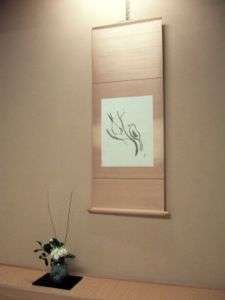Ikebana
Ikebana (生け花, 活け花, "arranging flowers" or "making flowers alive") is the Japanese art of flower arrangement.[1][2] It is also known as Kadō (華道, "way of flowers"). The tradition dates back to the 7th century when floral offerings were made at altars. Later, they were placed in the tokonoma (alcove) of a home. Ikebana reached its first zenith in the 16th century under the influence of Buddhist tea masters and has grown over the centuries, with over 1,000 different schools in Japan and abroad.
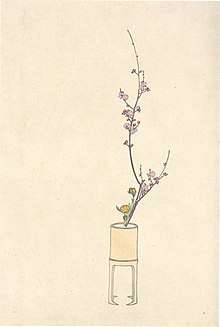
Kadō is counted as one of the three classical Japanese arts of refinement, along with kōdō for incense appreciation and chadō for tea and the tea ceremony.
Etymology
"Ikebana" is from the Japanese ikeru (生ける, "to arrange (flowers), have life, be living") and hana (花, "flower"). Possible translations include "giving life to flowers" and "arranging flowers".[3]
History
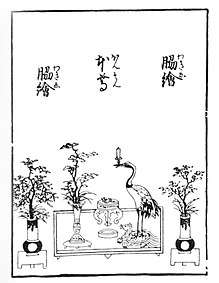

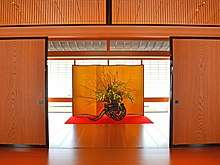
The pastime of viewing plants and appreciating flowers throughout the four seasons was established in Japan early on through the aristocracy. Waka poetry anthologies such as the Man'yōshū and Kokin Wakashū from the Heian period (794–1185) included many poems on the topic of flowers.[4] During this time, Buddhism was introduced to Japan starting in the 6th century through China and Korea. Offering flowers at Buddhist altars became common. Although the lotus is widely used in India where Buddhism originated, in Japan other native flowers for each season were selected for this purpose.[4] While in China the Buddhist priests were the first instructors of flower arrangement, in Japan they only introduced its crudest elements. For a long time the art had no meaning and was merely the placing in vases, without system, of the flowers to be used as temple offerings and before ancestral shrines. The first flower arrangements worked out with a system were known as shin-no-hana, meaning "central flower arrangement". A huge branch of pine or cryptomeria stood in the middle, and around the tree were placed three or five seasonable flowers. These branches and stems were put in vases in upright positions without attempt at artificial curves. Generally symmetrical in form, the arrangements appeared in Japanese religious pictures of the 14th century. It was the first attempt to represent natural scenery. The large tree in the center represented distant scenery, plum or cherry blossoms middle distance, and little flowering plants the foreground. The lines of these arrangements were known as centre and sub-centre.[5] Later on, among other types of Buddhist offering, placing mitsu-gusoku became popular in the Kamakura (1185–1333) and Nanboku-chō periods (1336–1392).[4] Various Buddhist scriptures have been named after flowers such as the Kegon-kyo (Flower Garland Sutra) and Hokke-kyo (Lotus Sutra). The Chōjū-jinbutsu-giga (Scroll of Frolicking Animals and Humans) depicts lotus being offered by a monk(ey) in front of a frog mimicking the Buddha.[4][6]
With the development of the shoin-zukuri architectural style starting in the Muromachi period (1336–1573), kakemono (scroll pictures) and containers could be suitable displayed as art objects in the oshiita, a precursor to the tokonoma alcove, and the chigaidana, two-leveled shelves. Also displayed in these spaces were flower arrangements in vases that influenced the interior decorations, which became simpler and more exquisite.[5] This style of decoration was called zashiki kazari (座敷飾).[7] The set of three ceremonial objects at the Buddhist altar called mitsugusoku consisted of candles lit in holders, a censer, and flowers in a vase. The flowers in the vase were arranged in the earliest style called tatebana or tatehana (立花, "standing flowers"), and were composed of shin (motoki) and shitakusa.[8] Recent historical research now indicates that the practice of tatebana[9] derived from a combination of belief systems, including Buddhist, and the Shinto yorishiro belief is most likely the origin of the Japanese practice of ikebana that we know today. Together they form the basis for the original purely Japanese derivation of the practice of ikebana.
The art developed very slowly, and the many schools did not come into existence until the end of the 15th century following the period of the civil war. The eighth shōgun Ashikaga Yoshimasa (1436–1490), was a patron of the arts and the greatest promoter of cha-no-yu, the ceremonial tea, and ikebana flower arrangement. Yoshimasa finally abdicated the office in order to devote his time to the fine arts. It was he who said that flowers offered on all ceremonial occasions and placed as offerings before the gods should not be offered loosely, but should represent time and thought. Rules then commenced to be formulated.[5]
It is to the celebrated painter Sōami, a contemporary and friend of Yoshimasa, who conceived the idea of representing the three elements of heaven, human, and earth, from which have grown the principles of the arrangements used today. It was at Yoshimasa's Silver Pavilion in Kyoto, where the art of cha-no-yu, the tea ceremony, and ko-awase, the incense ceremony, may be said to have been evolved that the art of ikebana received its great development.[5]
Artists of the Kanō school such as Sesshū Tōyō (1420–1506), Sesson, Kanō Masanobu, Kanō Motonobu (1476–1559), and Shugetsu of the 16th century were lovers of nature, so that ikebana advanced in this period a step further than temple and room decoration and commenced in a rudimentary way to consider natural beauty in floral arrangement. At this time ikebana was known as rikka.[5]
This same age conceived another form called nageirebana. Rikka and nageirebana are the two branches into which ikebana has been divided. Popularity of the two styles vacillated between these two for centuries. In the beginning, rikka was stiff, formal, and more decorative while nageirebana was simpler and more natural.[5]
Although nageirebana began to come into favour in the Higashiyama period, rikka was still preferred, and nageirebana did not truly gain popularity until the Momoyama period, about a hundred years after Ashikaga Yoshimasa. It was at this period that cha-no-yu reached its highest development and strongly influenced the flower art. A practitioner of tea was most probably also a follower of ikebana.[5]
After a long, hard struggle for existence as a dependent of rikka, nageirebana branched off and became independent and very popular. It was welcomed by the people of the 16th century for its freedom of line and natural beauty. So, while these two branches both started in the Higashiyama period, rikka better represents the taste of that time, and nageirebana more reflects the taste of the Momoyama period. Rikka lost some of its popularity in the Momoyama period, but in the first part of the Edo period (1603–1668) it was revived and became more popular than ever before.[5] In the Higashiyama period rikka had been used only as room decorations on ceremonial occasions, but now was followed as a fine art and looked upon as an accomplishment and pastime of the upper classes.[5]
Ikebana has always been considered a dignified accomplishment. All of Japan's most celebrated generals have been masters of this art, finding that it calmed their minds and made clear their decisions for the field of action. That warriors like Hideyoshi and Yoshimasa, two of Japan's most famous generals, found benefit in the practise of ikebana shows that it is valuable training, even for the masculine mind. Rikka reached its greatest popularity during the Genroku era.[5]
Many works on ikebana were published in the centuries from the Ken'ei (1206–1207) to the Genroku (1668–1704) eras, all founded on Sōami's idea of the three elements. The first of these works, published in the early part of the Ken'ei era, was a book called Sendenshō, and there were many others, but none of much value to the student of flower arrangement. They gave few rules and their chief object seemed to be to withhold all information. Although of little instructional value, these books were fully illustrated, thus documenting the gradual progress of the art. During the early Edo period (17th century) publications in Japan's developed rapidly. Books about ikebana were published in succession. During this time the Sendenshō (仙伝抄) was published and is the oldest published manual. The Kawari Kaden Hisho (替花伝秘書) came out in Kanbun 1 (1661). This was carefully written and very instructive, with rules and principles freely given.[5] In the Edo period, it was the second publication after the Sendenshō. Although the text is similar to the contents of commentaries of the Muromachi period, the illustrations showed how to enjoy Tachibana. Tachibana had spread from monks to warriors and further on to townspeople. The Kokon Rikka-shu (古今立花集) was the oldest published works on rikka in Kanbun 12 (1672). The Kokon Rikka-taizen (古今立花大全), published in Tenna 3 (1683), was the most famous rikka manual. The Rikka Imayō Sugata (立華時勢粧) came out Jōkyō 5 (1688).
In the Ken'ei era, rikka was simple and natural, with no extreme curves in the arrangement, but in the Genroku era, the lines became complicated and the forms pattern-like. This was an age of utmost elegance. All the fine arts were highly developed, above all pattern-printing for fabrics and decoration. In the latter part of the 17th century, Korin, the famous lacquer artist and essentially a creator of exquisite designs, strongly influenced ikebana. In this period, the combination of a pattern or design with lines that followed the natural growth of the plant produced the most pleasing and graceful results.[5]
It was in the latter part of the 17th century that ikebana was most practised and reached its highest degree of perfection as an art. Still, there were occasional departures into unnatural curves and artificialities that caused a shift, and nageirebana again revived. Until then only one branch of ikebana had been taught at a time, following the taste of the day, but now rival teachers in both rikka and nageirebana existed.[5]
Rikka reached its greatest popularity in the Genroku era, and then commenced its decline. From the decline of rikka, nageirebana, the origin of the present ikebana, grew in power and popularity. From this time on, it ceased to be called nageirebana and took the name of ikebana. In the Tenmei era (1781–1789) nageirebana, or ikebana, advanced rapidly in favour and developed great beauty of line. The exponents of the art not only studied nature freely, but combined this knowledge with that of rikka, the result bringing ikebana to a very perfect state of development.
After the Tenmei era a formal and artificial form of arrangement developed. This form has a fixed rule or model known as "heaven, human, and earth".[5] Is it known as Seika (生花), or Oseika, in many schools, or pronounced Shōka at Ikenobō. At Mishō-ryū the form is called Kakubana (格花).
The most popular schools of today, including Ikenobō, Enshū-ryū, Mishō-ryū, among others, adhere to these principles, but there are in Tokyo and Kyoto many masters of ikebana who teach the simpler forms of Ko-ryū, and Ko-Shin-ryū of the Genroku and Tenmei eras.[5]
The oldest international organization, Ikebana International, was founded in 1956.[10] Her Imperial Highness Princess Takamado is the honorary president.[11]
Followers
Followers and practitioners of kadō are known as kadōka (華道家). A kadō teacher is called sensei (先生).
Noted Japanese practitioners include Junichi Kakizaki, Mokichi Okada, and Yuki Tsuji. Tsuji was at a March 2015 TEDx in Shimizu, Shizuoka, where he elaborated on the relationship of ikebana to beauty.[12]
After the 2011 earthquake and tsunami devastation in Japan, noted ikebana practitioner Toshiro Kawase rose to popularity by posting images of his works online and gathering a global audience.[13]
Another practitioner is the Hollywood actress Marcia Gay Harden, who started when she was living in Japan as a child,[14] and has published a book on Ikebana with her own works.[15]
Schools
There are over 1,000 different types of schools of ikebana throughout the world today. A school is normally headed by an iemoto, oftentimes passed down within a family from one generation to the next. Some of the most historic and well-known schools are:[16]
Ikenobō goes back to the 700s CE of the Heian period and is considered the oldest school. This school marks its beginnings from the construction of the Rokkaku-dō in Kyoto, the second oldest Buddhist temple in Japan. It was built in 587 by Prince Shōtoku, who had camped near a pond in what is now central Kyoto, and enshrined a small statue of her. During the 13th century, Ono-no-Imoko, an official state emissary, brought the practice of placing Buddhist flowers on an altar from China. He became a priest at the temple and spent the rest of his days practicing flower arranging. The original priests of the temple lived by the side of the pond, for which the Japanese word is 'Ike' "池", and the word 'Bō' "坊", meaning priest, connected by the possessive particle 'no' ”の” gives the word 'Ikenobō' "池坊", "priest of the lake". The name Ikenobō, granted by the emperor, became attached to the priests there who specialized in altar arrangements.
Ikenobō is the only school that does not have the ending -ryū in its name, as it is considered the original school. The first systematized classical styles, including rikka, started in the middle of the 15th century. The first students and teachers were Ikenobō Buddhist priests and members of the Buddhist community. As time passed, other schools emerged, styles changed, and ikebana became a custom among the whole of Japanese society.[17]
- Ikenobō (池坊) is a development of rikka and considered the oldest school:
- Shōgetsudo Ko-ryū – originated by the monk Myōe (1171–1231)
- Ko-ryū (古流) – originated by Ōun Hoshi or Matsune Ishiro (1333–1402)
- Higashiyama Jishō-in-ryū (東山銀閣院流) – originated by Shōgun Ashikaga Yoshimasa (1436–1490), who was also called Higashiyama-dono or Jishō-in. Branches of this school are:
- Senzan-ryū
- Higashiyama-Ko-Sei-ryū
- Higashiyama-ryū (東山流)
- Sōami-ryū (相阿弥流)
- Senke-Ko-ryū – originated by the famous tea master Sen no Rikyū in 1520
- Bisho-ryū – originated by Goto Daigakunokami or Bishokui Dokaku in 1545
- Enshū-ryū (遠州流) – originated by Lord Kobori Enshū (1579–1647). The branches of this school are numerous:
- Nihonbashi Enshū-ryū
- Shin Enshū-ryū
- Ango Enshū-ryū
- Miyako Enshū-ryū
- Seifu Enshū-ryū
- Asakusa Enshū-ryū
and many others.
- Ko-Shin-ryū – originated by Shin-tetsu-sai, who was the teacher of Shōgun Tokugawa Hidetada (1579–1632)
- Sekishu-ryū – originated by Katagiri Iwaminokami Sadamasa (1604–1673)
- Jikei-ryū – originated by Shōuken Jikei in the year 1699
- Senkei-ryū – founded around 1669 by Senkei Tomiharunoki
- Tōgen-Ryu – commenced by Togensai Masayasu about 1716
- Sōgensai
- Murakumo-ryū
- Tōko-ryū
- Shikishima-ryū
- Dōnin-ryū
- Gengi-ryū – commenced by Chiba Ryōboku in the year 1772
- Mishō-ryū (未生流) – founded by Ippo Mishōsai (1761–1824) in Osaka
- Yōshin Go-ryū – developed during the Edo period
- Sei-ryū – commenced by Dōseiken Ittoku in 1818
- Shōko-ryū – commenced by Hakusuisai in the year 1896
- Ohara-ryū (小原流) – founded in 1895 by Ohara Unshin
- Sōgetsu-ryū (草月流) – founded in 1927 by Teshigahara Sofu
- Saga Go-ryū (嵯峨御流) – founded in the 1930s with roots dating back to Emperor Saga, who reigned from 809–823 CE
- Ichiyō (一葉) – founded in 1937
Other schools include Banmi Shōfū-ryū (晩美生風流), founded in 1962 by Bessie "Yoneko Banmi" Fooks, and Kaden-ryū (華伝流), founded by Kikuto Sakagawa in 1987 based on the Ikenobo school.
Theory
Since flower arrangement arrived in Japan from China together with Buddhism, it was naturally imbued with Chinese and Buddhist philosophy. The Buddhist desire to preserve life lies at the root of the whole subject and has created most of the rules of flower arrangement, controlling also the shapes of the flower vases, which are so formed as to help to prolong the life of the flowers. So much thought and time would never have been given to preservatives had not this desire predominated in all their floral offerings.[18]
The idea of good and evil fortune governs both the selection of material and the form of arrangement. The concept of hanakotoba (花言葉) is the Japanese form of the language of flowers. In this practice, plants are given codes and passwords. Physiological effects and action under the color of the flowers, put into words from the impressions of nature and the presence of thorns with the height of tall plants, flowers and garlands of flowers through the various types. These are meant to convey emotion and communicate directly to the recipient or viewer without needing the use of words. The colours of some flowers are considered unlucky. Red flowers, which are used at funerals, are undesirable not only for that reason but also because red is supposed to suggest the red flames of a fire. An odd number of flowers is lucky, while even numbers are unlucky and therefore undesirable, and never used in flower arrangements. With the odd numbers one avoids symmetry and equal balance, which are actually seldom found in nature, and which from the Japanese standpoint are never attractive in art of any description.
More than simply putting flowers in a container, ikebana is a disciplined art form in which nature and humanity are brought together. Contrary to the idea of a particolored or multicolored arrangement of blossoms, ikebana often emphasizes other areas of the plant, such as its stems and leaves, and puts emphasis on shape, line, and form. Though ikebana is an expression of creativity, certain rules govern its form. The artist's intention behind each arrangement is shown through a piece's color combinations, natural shapes, graceful lines, and the implied meaning of the arrangement.
Another common but not exclusive aspect present in ikebana is its employment of minimalism. Some arrangements may consist of only a minimal number of blooms interspersed among stalks and leaves. The structure of some Japanese flower arrangements is based on a scalene triangle delineated by three main points, usually twigs, considered in some schools to symbolize heaven, human, and earth, or sun, moon, and earth.[18] Use of these terms is limited to certain schools and is not customary in more traditional schools. A notable exception is the traditional rikka form, which follows other precepts. The container can be a key element of the composition, and various styles of pottery may be used in their construction. In some schools the container is only regarded as a vessel to hold water and should be subordinate to the arrangement.
Consideration of the vase as being something more than a mere holder of the flowers is purely Japanese. They think of the surface of the water, which they always expose, as the surface of earth from which the group springs. This aids in creating the effect of representing a complete plant growing as nearly as possible in its natural conditions.[18]
The Japanese express the seasons in their floral arrangements, grouping the flowers differently according to the time of the year. For example, in the month of March, when high winds prevail, the unusual curves of the branches convey at once the impression of strong winds. In summer the Japanese rejoice in the low, broad receptacles, where the visually predominating water produces a cooler and more refreshing arrangement than those in upright vases.[18]
There is no occasion which cannot be suggested by the manner in which the flowers are arranged.[18] It might seem strange to us to have our departure from home announced by an unusual arrangement of flowers. Yet hundreds of ordinary occurrences are heralded by charming flower compositions. So many Japanese poets have sung of the willow, comparing its very long branches with long life, happy married life, etc., that it is frequently used for many celebrations and is a great favorite for an arrangement made at parting, the length of branch insuring a safe return from the longest journey, especially if one branch is made to form a complete circle.[18]
For a house-warming, white flowers are used, as they suggest water to quench a fire, fire being their constant dread, as in the construction of many houses everything but the roof is flammable. Red flowers suggest fire, so are avoided on such occasions. To celebrate an inheritance all kinds of evergreens or chrysanthemums may be used, or any flowers which are long-lived, to convey the idea that the wealth or possessions may remain forever.[18]
There are appropriate arrangements for all felicitous occasions, as well as for sad ones. An offering at death should be of white flowers, with some dead leaves and branches, so arranged as to express peace. All gifts of flowers must be in bud, so that the person to whom they are sent may have the pleasure of seeing them open – quite a contrast to the present Western idea of everything being forced to perfection before leaving the florist.[18]
The spiritual aspect of kadō is considered very important to its practitioners. Some practitioners feel silence is needed while making ikebana while others feel this is not necessary. It is a time to appreciate things in nature that people often overlook because of their busy lives. It is believed that one becomes more patient and tolerant of differences, not only in nature, but also in general. Kadō can inspire one to identify with beauty in all art forms. This is also a time when one feels close to nature, which provides relaxation for the mind, body, and soul.
Plants play an important role in the Japanese Shinto religion. Yorishiro are objects that divine spirits are summoned to. Evergreen plants such as kadomatsu are a traditional decoration of the New Year placed in pairs in front of homes to welcome ancestral spirits or kami of the harvest.[4]
Styles
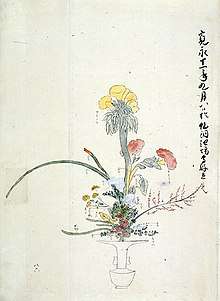
Patterns and styles evolved, and by the late 15th century arrangements were common enough to be appreciated by ordinary people and not only by the imperial family and its retainers.
Ikebana in the beginning was very simple, constructed from only a very few stems of flowers and evergreen branches. This first form of ikebana is called kuge (供華).
Styles of ikebana changed in the late 15th century and transformed into an art form with fixed instructions. Books were written about it, "Sedensho" being the oldest one, covering the years 1443 to 1536. Ikebana became a major part of traditional festivals, and exhibitions were occasionally held.
The first styles were characterized by a tall, upright central stem accompanied by two shorter stems. During the Momoyama period, 1560–1600, splendid castles were constructed. Noblemen and royal retainers made large decorative rikka floral arrangements that were considered appropriate decoration for castles.
- The Rikka (立花;[19] "standing flowers") style was developed as a Buddhist expression of the beauty of landscapes in nature. Key to this style are nine branches that represent elements of nature.[20] One of rikka arrangement styles is called suna-no-mono (砂の物; sand arrangement).[21]
When the tea ceremony emerged, another style was introduced for tea ceremony rooms called chabana. This style is the opposite of the Momoyama style and emphasizes rustic simplicity. Chabana is not considered a style of ikebana but is separate. The simplicity of chabana in turn helped create the nageirebana or "thrown-in" style.
- Nageirebana (投入花; "thrown-in flowers") is a non-structured design which led to the development of the seika or shoka style. It is characterized by a tight bundle of stems that form a triangular three-branched asymmetrical arrangement that was considered classic. It is also known by the short form nageire.
- Seika (生花;[22] "pure flowers") style consists of only three main parts, known in some schools as ten (heaven), chi (earth), and jin (human). It is a simple style that is designed to show the beauty and uniqueness of the plant itself. Formalization of the nageire style for use in the Japanese alcove resulted in the formal shoka style.
- In Moribana (盛花, "piled-up flowers"), flowers are arranged in a shallow vase or suiban, compote vessel, or basket, and secured on a kenzan or pointed needle holders, also known as metal frogs.
- Jiyūka (自由花;[23] "free flowers") is a free creative design. It is not confined to flowers; every material can be used. In the 20th century, with the advent of modernism, the three schools of ikebana partially gave way to what is commonly known in Japan as "Free Style".
Gallery
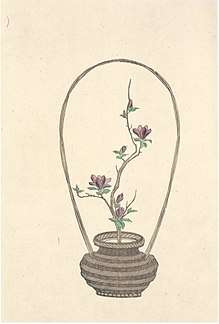 Traditional Shōka
Traditional Shōka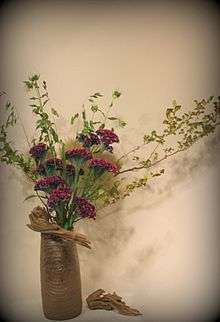 Nageire of the Banmi Shofu-ryū school
Nageire of the Banmi Shofu-ryū school.jpeg) Moribana kōseitai (hidarigatte) of the Saga Goryū school
Moribana kōseitai (hidarigatte) of the Saga Goryū school Jiyūka freestyle arrangement
Jiyūka freestyle arrangement
Vessels
The receptacles used in flower arranging come in a large variety. They are traditionally considered not only beautiful in form, material, and design but are made to suit the use to which they will be put, so that a flower can always be placed in an appropriate receptacle, and probably in one especially designed for that particular sort of flower.[24]
The thing the Japanese most seek in a vase's shape is what will best prolong the life of flowers. For this reason, vases are wide open at the mouth, for, unlike in Western flower arranging, they do not depend upon the vase itself to hold flowers in position, believing that the oxygen entering through the neck opening is as necessary to the plant as the oxygen it receives directly from the water; thus, the water remains sweet much longer than in small-necked vases.[24]
There are many ideas connected with these receptacles. For instance, hanging vases came into use through the idea that flowers presented by an esteemed friend should not be placed where they could be looked down upon, so they were raised and hung. In hanging bamboo vases, the large, round surface on top is supposed to represent the moon, and the hole for the nail a star. The cut, or opening, below the top is called fukumuki, the "wind drawing through a place".[24]
Besides offering variety in the form of receptacles, the low, flat vases, more used in summer than winter, make it possible to arrange plants of bulbous and water growth in natural positions.[24]
As for the color of the vases, the soft pastel shades are common, and bronze vases are especially popular. To the Japanese, the color bronze seems most like mother earth, and therefore best suited to enhance the beauty of flowers.[24]
Bamboo, in its simplicity of line and neutral color, makes a charming vase, but one of solid bamboo is not practical in some countries outside of Japan, where the dryness of the weather causes it to split. Baskets made from bamboo reeds, with their soft brown shades, provide a pleasing contrast to the varied tints of the flowers, and are practical in any climate.[24]
Not to be overlooked is the tiny hanging vase found in the simple peasant home – some curious root picked up at no cost and fashioned into a shape suitable to hold a single flower or vine. Such vases can be made with little effort by anyone and can find place nearly anywhere.[24]
 Hanging Moon and Hooked Vase
Hanging Moon and Hooked Vase Incoming or Boat of Good Fortune and Standard Arrangement
Incoming or Boat of Good Fortune and Standard Arrangement
In popular culture
Ikebana is taught in schools. It has also featured in manga, anime and been shown on television.
In Magic-kyun! Renaissance, the main character Aigasaki Kohana practices ikebana, just like her mother before her.[25]
The shōjo manga Zig Zag focuses on a boy named Takaaki Asakura (nicknamed "Taiyou" (the sun) and his affection for flowers.[26]
In 1957 the film director and grand master of the Sōgetsu-ryū Hiroshi Teshigahara made the movie titled Ikebana, which describes his school.[27] Flower and Sword, released in 2017, tells the story of the development of ikebana during the Sengoku period under the rule of the regent Toyotomi Hideyoshi in the 16th century. It was directed by Tetsuo Shinohara, and was based on a novel by Tadashi Onitsuka. It stars Kamejiro Ichikawa as Lord Hideyoshi, Mansai Nomura as the monk Senko Ikenobo, and Koichi Sato as Sen no Rikyu.[28] Masters and their assistants of the Ikenobo school were involved in creating the various rikka, shoka, and suna-no-mono arrangements for the movie.[29] Of particular note is a very large suna-no-mono arrangement that was recreated based on a historic piece arranged in the Maeda clan residence in Bunroku 3 (1594)[30] that took 14 people ten days to make and measured 3.5 m (11 ft) in height and 7.2 m (24 ft) in length.[29][31][32][33]
References
- "Ikebana International". www.ikebanahq.org. Archived from the original on 12 July 2014.
- "Definition of IKEBANA". www.merriam-webster.com. Archived from the original on 9 October 2017.
- The Modern Reader's Japanese-English Character Dictionary, Charles E. Tuttle Company, ISBN 0-8048-0408-7
- "History of Ikebana – IKENOBO ORIGIN OF IKEBANA". www.ikenobo.jp. Archived from the original on 10 December 2016.
- Averill, Mary. "Japanese flower arrangement". Archived from the original on 1 October 2017 – via Wikisource.
- Sojo, Toba. "English: A drawing of priests caricatured as animals". Archived from the original on 8 August 2017 – via Wikimedia Commons.
- System, Japanese Architecture and Art Net Users. "JAANUS / zashikikazari 座敷飾". www.aisf.or.jp. Archived from the original on 10 November 2016.
- "History of Ikebana – IKENOBO ORIGIN OF IKEBANA". www.ikenobo.jp. Archived from the original on 10 December 2016.
- "tatebana – Japanese art style". Archived from the original on 5 October 2016. Retrieved 19 October 2016.
- "Ikebana International". Archived from the original on 21 October 2016. Retrieved 19 October 2016.
- "Ikebana International". www.ikebanahq.org. Archived from the original on 21 October 2016.
- TEDx Talks (14 April 2015). "Ikebana ~Beyond Japanese art of flower~ - Yuki Tsuji – TEDxShimizu". Archived from the original on 11 November 2017 – via YouTube.
- Needleman, Deborah (6 November 2017). "The Rise of Modern Ikebana". The New York Times Style Magazine. Retrieved 4 April 2020.
- "Ikebana". 17 August 2011. Archived from the original on 2 October 2017.
- Marcia Gay Harden. The Seasons of My Mother: A Memoir of Love, Family, and Flowers. Atria Books. 2018. ISBN 978-1501135705
- Averill, Mary. "Japanese flower arrangement". Archived from the original on 13 September 2017 – via Wikisource.
- Kubo, keiko (2013). "introduction". Keiko's Ikebana: A Contemporary Approach to the Traditional Japanese Art of Flower Arranging. Tuttle Publishing. ISBN 978-1-4629-0600-0. Retrieved 25 August 2016.
- Averill, Mary. "Japanese flower arrangement". Archived from the original on 2 October 2017 – via Wikisource.
- "立花正風体、立花新風体とは|いけばなの根源 華道家元池坊". www.ikenobo.jp. Archived from the original on 4 October 2017.
- "ikebana-flowers.com". Archived from the original on 12 March 2015. Retrieved 19 October 2016.
- https://kotobank.jp/word/砂の物-542801 Archived 11 November 2017 at the Wayback Machine
- "生花正風体、生花新風体とは|いけばなの根源 華道家元池坊". www.ikenobo.jp. Archived from the original on 4 October 2017.
- "自由花とは|いけばなの根源 華道家元池坊". www.ikenobo.jp. Archived from the original on 4 October 2017.
- Averill, Mary. "Japanese flower arrangement". Archived from the original on 2 October 2017 – via Wikisource.
- https://lostinanime.com/2016/10/first-impressions-digest-touken-ranbu-hanamaru-magic-kyun-renaissance-chis-sweet-home-2016/
- https://www.animenewsnetwork.com/review/zig-zag/gn-1
- "Ikebana". 15 May 1957. Archived from the original on 10 February 2017 – via www.imdb.com.
- "Flower and Sword". 3 June 2017. Archived from the original on 13 March 2017 – via www.imdb.com.
- "いけばな|映画『花戦さ』オフィシャルサイト". 映画『花戦さ』オフィシャルサイト. Archived from the original on 7 October 2017.
- "池坊専好(初代)とは|映画『花戦さ』の主人公 池坊専好". www.ikenobo.jp. Archived from the original on 7 October 2017.
- ""Various Colors" 2017 Ikenobo Autumn Tanabata Exhibition – IKENOBO ORIGIN OF IKEBANA". www.ikenobo.jp. Archived from the original on 6 October 2017.
- "ようこそ!いけばなの世界へ - いけばなの根源 華道家元池坊". www.ikenobo.jp. Archived from the original on 7 October 2017.
- "Maeda ProjectM". www.ikenoboikebana.com. Archived from the original on 7 October 2017.
Further reading
- Ember, M., & Ember, C. R. (2001). Countries and their Cultures. New York Pearson Education, Inc. Retrieved 30 July 2008, from NetLibrary (UMUC Database) .
- Kubo, Keiko (2006). Keiko's Ikebana: A Contemporary Approach to the Traditional Japanese Art of Flower Arranging. North Clarendon: Tuttle Publishing. ISBN 978-0-8048-3651-7.
- Leaman, Oliver, ed. (2013). Encyclopedia of Asian Philosophy. London and New York: Taylor & Francis Routledge. ISBN 978-0-415-86253-0 https://sites.umuc.edu/library/libresources/. Retrieved 30 July 2008. Missing or empty
|title=(help) - Okakura, Kakuzō (1906). "Flowers". The Illustrated Book of Tea. London and New York: G. P. Putnam's Sons.
- Zamperini Pucci, Evi (1973). Davidson, Georgie (ed.). Japanese Flower Arranging. London: Orbis Book. ISBN 978-0-85613-139-4.
- Ohi, Minobu; Ikenobō, Sen'ei; Ohara, Hōun; Teshigahara, Sōfu (1996). Steere, William C. (ed.). Flower Arrangement: The Ikebana Way. Tokyo: Shufunotomo. ISBN 978-4079700818.
- Satō, Shōzō (1968). The Art of Arranging Flowers: A Complete Guide to Japanese Ikebana. New York: Harry N. Abrams. ISBN 978-0-8109-0194-0.
- Ingelaere-Brandt, Mit; Van Moerbeke, Katrien (2015). Poetical Ikebana. Oostkamp: Stichting Kunstboek. ISBN 978-9058565198.
- Conder, Josiah (1899). The Floral Art of Japan. Tokyo: Kelly and Walsh, Ltd.
- Averill, Mary (1913). Japanese Flower Arrangement. New York: John Lane Company.
